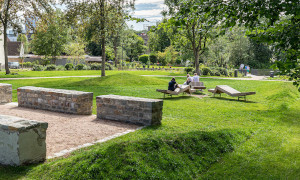With influx and space consumption, densification is an option. Turning it into an asset for the citizens of the city is an obligation! What does the city need? A commitment to it!
The city government is responsible for building space and building law in order to meet the needs for living and the wishes for development. And public space is an indispensable part of this, a meeting place for its citizens. At present, this need is not taken into account, although it is the prerequisite for urban society and democracy.
In the competitions of recent years, the focus is on the planning area and a solution for the public space is sought within it. The result is always a semi-public space unconnected to the city, which can quickly turn into a guarded space with many taboos. Strange children play without permission, strange people linger in it, dogs etc. become a nuisance.
Neighborhood community is legitimate and necessary, but comes into conflict with the public realm. Spaces have been created that only appear to be open, spaces that are more of a "hostile openness"; recent example Domagk Street.
The City has long failed in its duty to establish or defend Public Space for its citizens. Recognition of this shortcoming must finally lead to fruitful consequences. Urban density, when Public Space exists, is an asset. This is where urban society sees and meets. Here is the place where parallel societies can become ONE society through meeting.
The question remains, so where can densification combine with the creation of Public Spaces? The potential lies in the main thoroughfares and in the major access roads, where densification can also create public space.
In Munich, Wasserburger Landstrasse can serve as an example: a four-lane roadway with a central divider and single-family housing development. This is where the potential for society-friendly densification lies; building rights should be created here: ground floor and four upper floors, which at the same time protects the less built-up rear side, e.g. the garden city.
The ground floor belongs to the public space. Local supply must be made possible here. Daycare centers, kindergartens, care can find space here and the changing demand for startups, art, studios, crafts and gastronomy etc. can unfold and create public space.
The time is right. Exhaust and noise pollution will drop dramatically in a few years. The development is here and needs little additional investment. Demand for public transit can be met most easily here.
The old incorporated village centers can also be given new, public roles. Here, the historical connections of the city become tangible. There is also potential here for densification along the approaching streets.
The BauGB had recently provided the instruments, urban development only has to commit itself to the city and take hold of it.
Wolfgang Czisch
Munich Forum, Working Group City, Shape and Living Space
- Latitude: 0
- Longitude: 0


